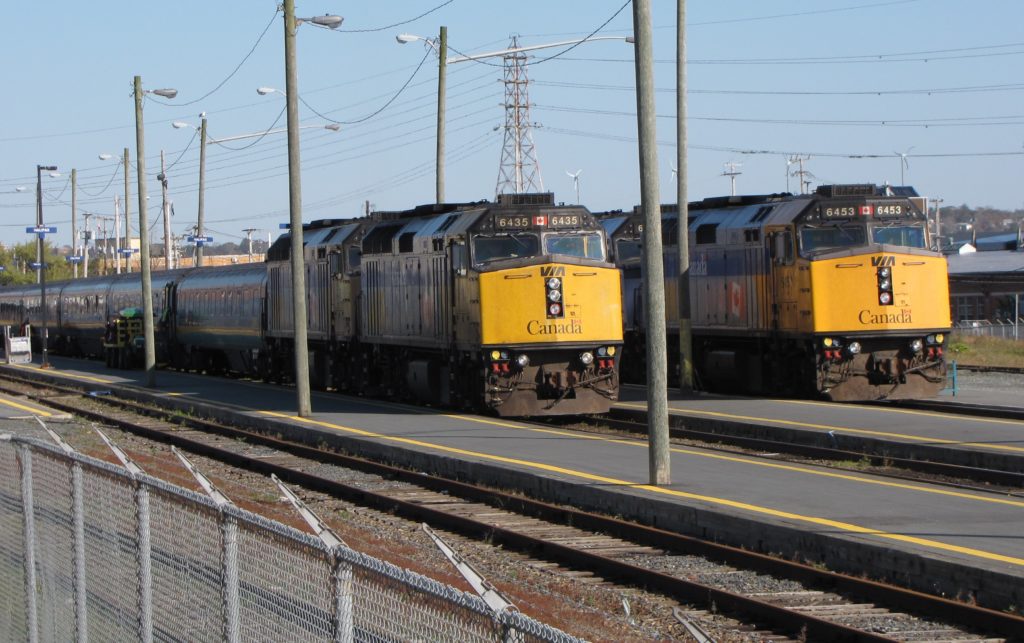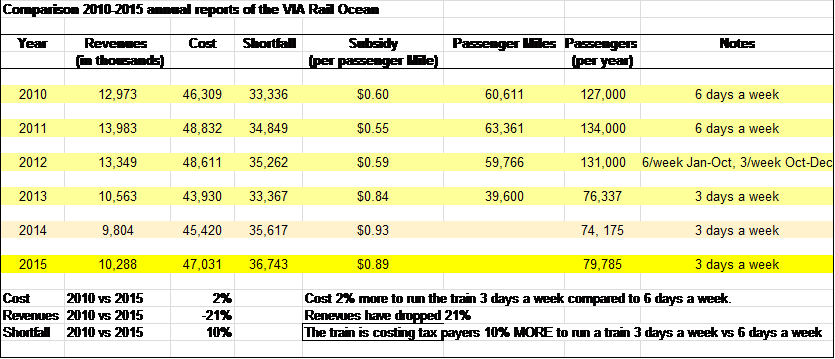
When VIA Rail cut service on the Montreal-Halifax Ocean in half back near the end of 2012, they claimed that the move was made to reduce the cost of running the service. The Ocean, like all of VIA’s services (and indeed, nearly all public transportation systems worldwide), operates at a net “loss”, with subsidies required to offset the operating costs of the service. Trains like the Ocean require a somewhat higher subsidy per passenger than VIA’s Corridor services, and VIA management was supposedly looking for ways to reduce spending across the system. So the Ocean was reduced from 6 day per week operation to only 3.
Passenger rail advocates, including Transport Action Atlantic, raised their voices at the time to warn of the implications of slashing the service. Examples from Canada and elsewhere in the world continue to show that frequency reductions are not an effective means of reducing costs – while they may result in some immediate cost savings, any cost reductions are offset almost without fail by greater reductions in ridership as a result of the less convenient service.
The problem with reduced frequency is that costs don’t come down enough, while revenues plummet. Reducing a service like the Ocean to a lower frequency does reduce some costs, but not all of them, as many fixed costs remain (e.g. maintenance of stations and other infrastructure, equipment costs, some personnel costs, marketing). In other words, a 50% reduction in train frequency does not result in a 50% reduction in costs. VIA’s numbers since 2012 back this up: in 2011, the Ocean cost $48,832,000 to operate 6 days per week. In 2013, that cost was reduced to $43,930,000 for 3 trains per week – a reduction of barely 10%.
By contrast, the passenger revenues for the service dropped much more dramatically. Passenger revenues for 2011 were at $13,983,000 with 6 trains per week, and dropped to $10,563,000 in 2013 following the cuts (and even lower in 2014 and 2015), a roughly 25% reduction.
As a result, a service that had a shortfall of $34,849,000 running 6 trains per week became one with a shortfall of $33,367,000 running 3 trains a week.
What’s even more shocking is what happened in the following two years. Costs actually increased further in 2014 and 2015, while revenues continued to drop. So the Ocean managed to actually have a higher net shortfall in 2014 and 2015 than it had in 2010 or 2011, despite running only half the trains! The 2015 numbers show this trend expanding even further from where it was the last few years. The shortfall is now up to $36,743,000.
The other consequence of this change is the subsidy per passenger mile, a useful metric for the efficiency of running the service. In 2011, that figure was as low as $0.55 subsidy per passenger mile; in 2015, it was $0.89, more than a 60% increase.
Figure 1: This table shows a comparison of the revenues, costs, shortfalls, and subsidy per passenger mile from 2010 to 2015, noting where the reduction in frequency took place*. Numbers were extracted from VIA’s public annual reports.
So what’s the takeaway message from these numbers? Basically, VIA’s argument that cutting the Ocean’s frequency to 3 trains a week was necessary to save costs was simply wrong. Reducing the frequency has, as many predicted, caused a decline in ridership that offset any savings from running fewer trains, and has resulted in a service that costs VIA more both in absolute terms, and on a per-passenger basis.
With numbers like these, how can VIA possibly justify continuing to operate a tri-weekly service? It clearly isn’t working. Examples from around the world, including Amtrak to the south, have shown time and time again that increased frequency will drive increases in ridership. Without doing that, none of VIA’s best efforts to improve the service are likely to matter, and they will continue to spend more money while serving fewer people.
The Ocean may be a comfortable, enjoyable way for people to travel, but when you can’t book a train on the majority of days in the week, more and more people are going to continue to look at other options to get where they need to go, when they need to.
*Special thanks to Save our Trains in Northern New Brunswick for providing the assessment in the above table.







VIA does not have enough Renaissance cars to make up another train set. They are cannibalizing a decreasing fleet to keep the ones they have operating. Built in 1995-96. these cars are already 20 years old and are certainly not worth major rehabilitation. Our only hope for the future of the Ocean is to somehow convince the federal government to buy enough new equipment for a daily service.